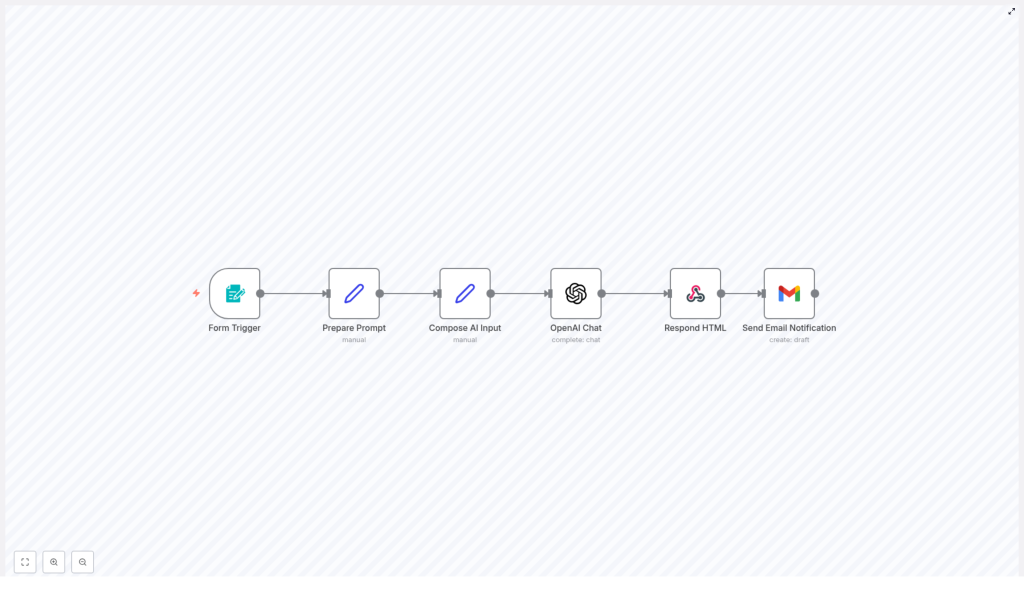Auto-Document n8n Workflows with AI
Use this lightweight n8n template to generate concise, SEO-friendly documentation for any n8n workflow using a form trigger and OpenAI.
Why this template matters
This template solves a common pain point for no-code teams and developers: keeping workflow documentation up to date. Instead of manually writing documentation every time a workflow changes, this automation generates clear, concise documentation on demand using OpenAI. The result is consistent, searchable, and shareable documentation for your n8n workflows.
Who is this for?
- n8n users who maintain multiple workflows
- Developers and automation engineers who need consistent documentation
- Customer-facing teams that hand off automations to other departments
- Technical writers looking to speed up workflow documentation
Use cases
- Automatically create documentation during handoffs or releases
- Generate quick summaries to include in changelogs or internal wikis
- Provide onboarding materials for new team members
- Produce email-ready documentation for stakeholders
What this workflow does
At a high level, the template takes a workflow JSON submitted via a form, prepares a concise prompt, calls OpenAI to generate documentation, returns an HTML response, and sends an email notification with the generated content. The entire flow is designed to be brief and focused on producing useful documentation quickly.
How it works — node-by-node
The template is composed of six main nodes. Each node has a specific purpose in the documentation pipeline.
1. Form Trigger
Purpose: Collect the workflow title and the workflow JSON from the user.
- Trigger type: Form
- Inputs: Workflow Title (required), Workflow JSON (required)
- When to use: Submit any n8n workflow JSON you want documented
2. Prepare Prompt (Set)
Purpose: Build the instruction text that tells the AI how to format the documentation. This node stores a concise prompt that emphasizes brevity and structure to improve output quality.
3. Compose AI Input (Set)
Purpose: Combine the form inputs (title and JSON) with the prepared prompt into a single payload. This node builds the exact text the OpenAI Chat model will receive.
4. OpenAI Chat
Purpose: Send the composed prompt to OpenAI (GPT-4 chat) to generate the documentation.
- Model: GPT-4 chat (configured in the template)
- Output: A concise documentation message in plain text or markdown
5. Respond HTML
Purpose: Return the generated documentation as an HTML response so the form submitter sees it immediately in the browser. This node includes a minimal HTML wrapper and simple styles for readability.
6. Send Email Notification
Purpose: Email the generated documentation to a configured recipient so stakeholders receive the documentation automatically. The template uses a Gmail node in draft mode but can be switched to any email provider.
Setup guide
Getting started takes only a few steps:
- Import the template into your n8n instance.
- Open the workflow and set up credentials: OpenAI API key and your email provider (e.g., Gmail).
- Customize the recipient address in the Send Email Notification node.
- Preview the template by submitting a sample workflow JSON through the form trigger.
- When satisfied, share the form URL with your team or embed it in an internal tool.
Tips to customize
You can adapt the template for different outcomes depending on how you want your documentation to look:
- Adjust the prompt in Prepare Prompt to change tone (e.g., formal, conversational) or length (brief vs. detailed).
- Switch the OpenAI model or tweak temperature and max tokens to control creativity and length.
- Add a node to save generated docs to a knowledge base (Google Drive, Notion, Confluence, or an S3 bucket).
- Append a step to create a Github/GitLab snippet or a wiki page automatically.
- Modify the HTML wrapper in Respond HTML for branded output or to include screenshots and diagrams.
Example output structure
The template asks the model to return a compact document that typically includes:
- Short title and one-line summary
- Who it’s for and the primary use case
- How it works (brief step list)
- Setup instructions and customization tips
Best practices and troubleshooting
Best practices
- Provide clean, valid workflow JSON for the best results — remove large binary blobs or unrelated metadata.
- Test with a few different workflows to tune the prompt and model settings.
- Keep the prompt concise and explicit about structure; the template already favors brevity.
Troubleshooting
- If you get incomplete output, increase the model’s max tokens or split very large workflows into sections.
- If the email fails, verify your email node credentials and consider using SMTP or an API-driven email node.
- If the form submission shows errors, check webhook permissions and ensure the form trigger path is correct.
Security and privacy
Remember that sending workflow JSON to an external API (OpenAI) may include sensitive metadata. Remove credentials, API keys, or private tokens from the JSON before submission. If you must include sensitive data, consider running a self-hosted model or restricting access to the template form.
Wrap-up and next steps
This n8n template transforms tedious documentation tasks into a quick, repeatable process. It’s ideal for teams that want consistent, searchable documentation for automations without the manual overhead.
Try it now: Import the template into n8n, add your OpenAI credentials, and submit a workflow JSON via the form trigger. If you want deeper automation, connect storage or wiki nodes to archive docs automatically.

